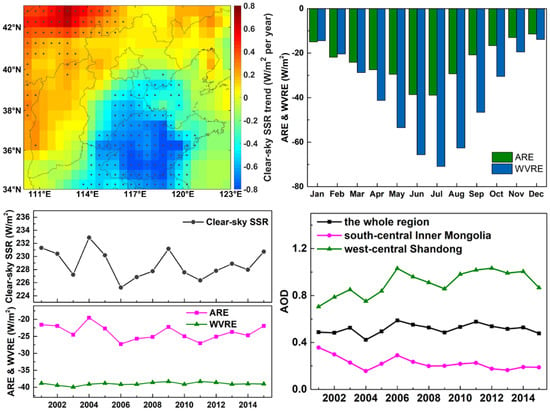Clear-Sky Surface Solar Radiation and the Radiative Effect of Aerosol and Water Vapor Based on Simulations and Satellite Observations over Northern China
Abstract
1. Introduction
2. Materials and Methods
2.1. Data
2.2. Methodology
2.2.1. Simulation of Clear-Sky SSR and Calculation of ARE and WVRE
2.2.2. Validation of Simulated Clear-Sky SSR
3. Results
3.1. Spatial Pattern of Clear-Sky SSR and Associated Factors in North China
3.2. Seasonal Variation of Clear-Sky SSR and Driving Factors in North China
3.3. Long-Term Trend of Clear-Sky SSR and the Roles of Aerosol and Water Vapor in Northern China
4. Discussion
5. Conclusions
Author Contributions
Funding
Acknowledgments
Conflicts of Interest
References
- Sanchez-Lorenzo, A.; Wild, M. Decadal variations in estimated surface solar radiation over Switzerland since the late 19th century. Atmos. Chem. Phys. Discuss. 2012, 12, 8635–8644. [Google Scholar] [CrossRef]
- Wild, M. Enlightening Global Dimming and Brightening. Bull. Am. Meteorol. Soc. 2012, 93, 27–37. [Google Scholar] [CrossRef]
- Xu, J.; Li, C.; Shi, H.; He, Q.; Pan, L. Analysis on the impact of aerosol optical depth on surface solar radiation in the Shanghai megacity, China. Atmos. Chem. Phys. Discuss. 2011, 11, 3281–3289. [Google Scholar] [CrossRef]
- Valipour, M. Importance of solar radiation, temperature, relative humidity, and wind speed for calculation of reference evapotranspiration. Arch. Agron. Soil Sci. 2014, 61, 239–255. [Google Scholar] [CrossRef]
- Ren, X.; He, H.; Zhang, L.; Yu, G.-R. Global radiation, photosynthetically active radiation, and the diffuse component dataset of China, 1981–2010. Earth Syst. Sci. Data 2018, 10, 1217–1226. [Google Scholar] [CrossRef]
- Europe, S.P. Global Market Outlook for Solar Power 2019–2023; SolarPower Europe: Brussels, Belgium, 2019. [Google Scholar]
- Qian, Y.; Wang, W.; Leung, L.R.; Kaiser, D.P. Variability of solar radiation under cloud-free skies in China: The role of aerosols. Geophys. Res. Lett. 2007, 34. [Google Scholar] [CrossRef]
- Shi, G.-Y.; Hayasaka, T.; Ohmura, A.; Chen, Z.-H.; Wang, B.; Zhao, J.-Q.; Che, H.; Xu, L. Data Quality Assessment and the Long-Term Trend of Ground Solar Radiation in China. J. Appl. Meteorol. Clim. 2008, 47, 1006–1016. [Google Scholar] [CrossRef]
- Karakoti, I.; Pathak, P.P.; Nandan, H. A Comprehensive Study of Ground Measurement and Satellite-Derived Data of Global and Diffuse Radiation. Environ. Prog. Sustain. Energy 2018, 38, e13060. [Google Scholar] [CrossRef]
- Fröhlich, C. Variability of the solar “constant” on time scales of minutes to years. J. Geophys. Res. Space Phys. 1987, 92, 796. [Google Scholar] [CrossRef]
- Liepert, B.G. Observed reductions of surface solar radiation at sites in the United States and worldwide from 1961 to 1990. Geophys. Res. Lett. 2002, 29, 61. [Google Scholar] [CrossRef]
- Abakumova, G.M.; Feigelson, E.M.; Russak, V.; Stadnik, V.V. Evaluation of Long-Term Changes in Radiation, Cloudiness, and Surface Temperature on the Territory of the Former Soviet Union. J. Clim. 1996, 9, 1319–1327. [Google Scholar] [CrossRef][Green Version]
- Li, J.; Yu, R.; Zhou, T.; Wang, B. Why Is There an Early Spring Cooling Shift Downstream of the Tibetan Plateau? J. Clim. 2005, 18, 4660–4668. [Google Scholar] [CrossRef]
- Kaiser, D.P. Decreasing cloudiness over China: An updated analysis examining additional variables. Geophys. Res. Lett. 2000, 27, 2193–2196. [Google Scholar] [CrossRef]
- Haywood, J.; Bellouin, N.; Jones, A.; Boucher, O.; Wild, M.; Shine, K.P. The roles of aerosol, water vapor and cloud in future global dimming/brightening. J. Geophys. Res. Space Phys. 2011, 116, 116. [Google Scholar] [CrossRef]
- Wild, M.; Trüssel, B.; Ohmura, A.; Long, C.N.; König-Langlo, G.; Dutton, E.G.; Tsvetkov, A. Global dimming and brightening: An update beyond 2000. J. Geophys. Res. Space Phys. 2009, 114, 114. [Google Scholar] [CrossRef]
- Malm, W.C.; Walther, E.G.; Cudney, R.A. The Effects of Water Vapor, Ozone and Aerosol on Atmospheric Turbidity. J. Appl. Meteorol. 1977, 16, 268–274. [Google Scholar] [CrossRef]
- Satheesh, S.K.; Ramanathan, V. Large differences in tropical aerosol forcing at the top of the atmosphere and Earth’s surface. Nature 2000, 405, 60–63. [Google Scholar] [CrossRef]
- Kanakidou, M.; Seinfeld, J.H.; Pandis, S.N.; Barnes, I.; Dentener, F.J.; Facchini, M.C.; van Dingenen, R.; Ervens, B.; Nenes, A.; Nielsen, C.J.; et al. Organic aerosol and global climate modelling: A review. Atmos. Chem. Phys. Discuss. 2004, 4, 5855–6024. [Google Scholar] [CrossRef]
- Radke, L.F.; Coakley, J.A.; King, M.D. Direct and Remote Sensing Observations of the Effects of Ships on Clouds. Science 1989, 246, 1146–1149. [Google Scholar] [CrossRef]
- Andreae, M.O.; Rosenfeld, D. Aerosol–cloud–precipitation interactions. Part 1. The nature and sources of cloud-active aerosols. Earth-Sci. Rev. 2008, 89, 13–41. [Google Scholar] [CrossRef]
- Norris, J.R.; Wild, M. Trends in aerosol radiative effects over Europe inferred from observed cloud cover, solar “dimming,” and solar “brightening”. J. Geophys. Res. Space Phys. 2007, 112. [Google Scholar] [CrossRef]
- Qian, Y.; Kaiser, D.P.; Leung, L.R.; Xu, M. More frequent cloud-free sky and less surface solar radiation in China from 1955 to 2000. Geophys. Res. Lett. 2006, 33. [Google Scholar] [CrossRef]
- Tzanis, C.G.; Varotsos, C. Tropospheric aerosol forcing of climate: A case study for the greater area of Greece. Int. J. Remote. Sens. 2008, 29, 2507–2517. [Google Scholar] [CrossRef]
- Boucher, O.; Pham, M. History of sulfate aerosol radiative forcings. Geophys. Res. Lett. 2002, 29. [Google Scholar] [CrossRef]
- Kaufman, Y.J.; Tanre, D.; Holben, B.N.; Mattoo, S.; Remer, L.A.; Eck, T.F.; Vaughan, J.; Chatenet, B. Aerosol Radiative Impact on Spectral Solar Flux at the Surface, Derived from Principal-Plane Sky Measurements. J. Atmos. Sci. 2002, 59, 635–646. [Google Scholar] [CrossRef]
- Obregón, M.A.; Costa, M.J.; Serrano, A.; Silva, A.M. Effect of water vapor in the SW and LW downward irradiance at the surface during a day with low aerosol load. In Proceedings of the IOP Conference Series: Earth and Environmental Science, Elche, Spain, 29 June–1 July 2015; IOP Publishing: Bristol, UK, 2015; p. 12009. [Google Scholar]
- Hakuba, M.Z.; Folini, D.; Wild, M. On the Zonal Near-Constancy of Fractional Solar Absorption in the Atmosphere. J. Clim. 2016, 29, 3423–3440. [Google Scholar] [CrossRef]
- Donohoe, A.; Battisti, D.S. What Determines Meridional Heat Transport in Climate Models? J. Clim. 2012, 25, 3832–3850. [Google Scholar] [CrossRef]
- Schwarz, M.; Folini, D.; Yang, S.; Wild, M. The Annual Cycle of Fractional Atmospheric Shortwave Absorption in Observations and Models: Spatial Structure, Magnitude, and Timing. J. Clim. 2019, 32, 6729–6748. [Google Scholar] [CrossRef]
- Fu, D.; Song, Z.; Zhang, X.; Xia, X.; Wang, J.; Che, H.; Wu, H.; Tang, X.; Zhang, J.; Duan, M. Mitigating MODIS AOD non-random sampling error on surface PM2.5 estimates by a combined use of Bayesian Maximum Entropy method and linear mixed-effects model. Atmos. Pollut. Res. 2020, 11, 482–490. [Google Scholar] [CrossRef]
- Song, Z.; Fu, D.; Zhang, X.; Wu, Y.; Xia, X.; He, J.; Han, X.; Zhang, R.; Che, H. Diurnal and seasonal variability of PM2.5 and AOD in North China plain: Comparison of MERRA-2 products and ground measurements. Atmos. Environ. 2018, 191, 70–78. [Google Scholar] [CrossRef]
- Zhang, J.; Xia, X.; Zong, X.; Fan, X.; Chen, H.; Li, J. Dust Properties and Radiative Impacts at a Suburban Site during 2004–2017 in the North China Plain. Remote. Sens. 2019, 11, 1842. [Google Scholar] [CrossRef]
- Cao, L.Q.; Yu, J.H.; Ge, Z.X. Water vapor content in the atmosphere and its variation trend over North China. Adv. Water Sci. 2005, 16, 439–443. [Google Scholar] [CrossRef]
- Zhang, X.; Xia, X.; Xuan, C. On the drivers of variability and trend of surface solar radiation in Beijing metropolitan area. Int. J. Clim. 2014, 35, 452–461. [Google Scholar] [CrossRef]
- Song, J.; Xia, X.; Che, H.; Wang, J.; Zhang, X.; Li, X. Daytime variation of aerosol optical depth in North China and its impact on aerosol direct radiative effects. Atmos. Environ. 2018, 182, 31–40. [Google Scholar] [CrossRef]
- Che, H.; Xia, X.; Zhu, J.; Li, Z.; Dubovik, O.; Holben, B.; Goloub, P.; Chen, H.; Estelles, V.; Cuevas, E.; et al. Column aerosol optical properties and aerosol radiative forcing during a serious haze-fog month over North China Plain in 2013 based on ground-based sunphotometer measurements. Atmos. Chem. Phys. Discuss. 2014, 14, 2125–2138. [Google Scholar] [CrossRef]
- King, M.D.; Menzel, W.P.; Kaufman, Y.; Tanre, D.; Gao, B.-C.; Platnick, S.; Ackerman, S.; Remer, L.; Pincus, R.; Hubanks, P. Cloud and aerosol properties, precipitable water, and profiles of temperature and water vapor from MODIS. IEEE Trans. Geosci. Remote. Sens. 2003, 41, 442–458. [Google Scholar] [CrossRef]
- Levy, R.C.; Mattoo, S.; Munchak, L.A.; Remer, L.A.; Sayer, A.M.; Patadia, F.; Hsu, N.C. The Collection 6 MODIS aerosol products over land and ocean. Atmos. Meas. Tech. 2013, 6, 2989–3034. [Google Scholar] [CrossRef]
- Sayer, A.M.; Munchak, L.A.; Hsu, N.C.; Levy, R.C.; Bettenhausen, C.; Jeong, M.-J. MODIS Collection 6 aerosol products: Comparison between Aqua’s e-Deep Blue, Dark Target, and “merged” data sets, and usage recommendations. J. Geophys. Res. Atmos. 2014, 119, 13965–13989. [Google Scholar] [CrossRef]
- Ruiz-Arias, J.A.; Dudhia, J.; Gueymard, C.A.; Pozo-Vazquez, D. Assessment of the Level-3 MODIS daily aerosol optical depth in the context of surface solar radiation and numerical weather modeling. Atmos. Chem. Phys. Discuss. 2013, 13, 675–692. [Google Scholar] [CrossRef]
- Kinne, S.; Schulz, M.; Textor, C.; Guibert, S.; Balkanski, Y.; Bauer, S.E.; Berntsen, T.; Berglen, T.F.; Boucher, O.; Chin, M.; et al. An AeroCom initial assessment—Optical properties in aerosol component modules of global models. Atmos. Chem. Phys. Discuss. 2006, 6, 1815–1834. [Google Scholar] [CrossRef]
- Lacagnina, C.; Hasekamp, O.P.; Bian, H.S.; Curci, G.; Myhre, G.; van Noije, T.; Schulz, M.; Skeie, R.B.; Takemura, T.; Zhang, K. Aerosol single-scattering albedo over the global oceans: Comparing PARASOL retrievals with AERONET, OMI, and AeroCom models estimates. J. Geophys. Res. Atmos. 2015, 120, 9814–9836. [Google Scholar] [CrossRef]
- Holben, B.; Eck, T.; Slutsker, I.; Tanre, D.; Buis, J.; Setzer, A.; Vermote, E.; Reagan, J.; Kaufman, Y.; Nakajima, T.; et al. AERONET—A Federated Instrument Network and Data Archive for Aerosol Characterization. Remote. Sens. Environ. 1998, 66, 1–16. [Google Scholar] [CrossRef]
- Boilley, A.; Wald, L. Comparison between meteorological re-analyses from ERA-Interim and MERRA and measurements of daily solar irradiation at surface. Renew. Energy 2015, 75, 135–143. [Google Scholar] [CrossRef]
- Zhang, Y.; Cai, C.; Chen, B.; Dai, W. Consistency Evaluation of Precipitable Water Vapor Derived from ERA5, ERA-Interim, GNSS, and Radiosondes Over China. Radio Sci. 2019, 54, 561–571. [Google Scholar] [CrossRef]
- Gelaro, R.; Mccarty, W.; Suárez, M.J.; Todling, R.; Molod, A.; Takacs, L.; Randles, C.; Darmenov, A.; Bosilovich, M.G.; Reichle, R.H.; et al. The Modern-Era Retrospective Analysis for Research and Applications, Version 2 (MERRA-2). J. Clim. 2017, 30, 5419–5454. [Google Scholar] [CrossRef] [PubMed]
- Molod, A.; Takács, L.; Suárez, M.; Bacmeister, J. Development of the GEOS-5 atmospheric general circulation model: Evolution from MERRA to MERRA2. Geosci. Model Dev. 2015, 8, 1339–1356. [Google Scholar] [CrossRef]
- Müller, R.; Matsoukas, C.; Gratzki, A.; Behr, H.; Hollmann, R. The CM-SAF operational scheme for the satellite based retrieval of solar surface irradiance—A LUT based eigenvector hybrid approach. Remote. Sens. Environ. 2009, 113, 1012–1024. [Google Scholar] [CrossRef]
- Emde, C.; Buras-Schnell, R.; Kylling, A.; Mayer, B.; Gasteiger, J.; Hamann, U.; Kylling, J.; Richter, B.; Pause, C.; Dowling, T.; et al. The libRadtran software package for radiative transfer calculations (Version 2.0). Geosci. Model Dev. Discuss. 2015, 8, 10237–10303. [Google Scholar] [CrossRef]
- Christopher, S.; Zhang, J.; Kaufman, Y.J.; Remer, L.A. Satellite-based assessment of top of atmosphere anthropogenic aerosol radiative forcing over cloud-free oceans. Geophys. Res. Lett. 2006, 33. [Google Scholar] [CrossRef]
- Silvestre, M.R.; Silvestre, M.R. Temporal decomposition, and harmonic regression models: A comparison to the series of monthly average minimum and maximum temperature at presidente prudente (sp). Rev. Bras. Meteorol. 2015, 30, 157–185. [Google Scholar]
- Levine, D.; Crews, K. Time series harmonic regression analysis reveals seasonal vegetation productivity trends in semi-arid savannas. Int. J. Appl. Earth Obs. Geoinform. 2019, 80, 94–101. [Google Scholar] [CrossRef]
- Weatherhead, E.; Reinsel, G.C.; Tiao, G.C.; Meng, X.-L.; Choi, D.; Cheang, W.-K.; Keller, T.; de Luisi, J.; Wuebbles, D.J.; Kerr, J.B.; et al. Factors affecting the detection of trends: Statistical considerations and applications to environmental data. J. Geophys. Res. Space Phys. 1998, 103, 17149–17161. [Google Scholar] [CrossRef]
- Bartók, B. Aerosol radiative effects under clear skies over Europe and their changes in the period of 2001–2012. Int. J. Clim. 2016, 37, 1901–1909. [Google Scholar] [CrossRef]
- Long, C.N.; Ackerman, T.P. Identification of clear skies from broadband pyranometer measurements and calculation of downwelling shortwave cloud effects. J. Geophys. Res. Space Phys. 2000, 105, 15609–15626. [Google Scholar] [CrossRef]
- Otunla, T.A. Estimates of clear-sky solar irradiances over Nigeria. Renew. Energy 2019, 131, 778–787. [Google Scholar] [CrossRef]
- Zhang, C.; Wen, M. Using Satellite Data to Estimate Solar Radiation of Clear Sky over Fujian. J. Nat. Res. 2014, 29, 1496–1507. [Google Scholar]
- Song, Z.; Fu, D.; Zhang, X.; Han, X.; Song, J.; Zhang, J.; Wang, J.; Xia, X. MODIS AOD sampling rate and its effect on PM2.5 estimation in North China. Atmos. Environ. 2019, 209, 14–22. [Google Scholar] [CrossRef]
- Feng, N.; Christopher, S. Clear sky direct radiative effects of aerosols over Southeast Asia based on satellite observations and radiative transfer calculations. Remote. Sens. Environ. 2014, 152, 333–344. [Google Scholar] [CrossRef]
- Marty, C.; Philipona, R.; Fröhlich, C.; Ohmura, A.; Marty, C. Altitude dependence of surface radiation fluxes and cloud forcing in the alps: Results from the alpine surface radiation budget network. Theor. Appl. Clim. 2002, 72, 137–155. [Google Scholar] [CrossRef]
- Qian, X.; Yao, Y.Q.; Li, J.R.; Yin, J.; Ma, J.L. The Distribution of Precipitable Water Vapor over China. Acta Astronom. Sin. 2012, 53, 325–341. [Google Scholar]
- Yu, M.; Ellis, J.E.; Epstein, H.E. Regional Analysis of Climate, Primary Production, and Livestock Density in Inner Mongolia. J. Environ. Qual. 2004, 33, 1675–1681. [Google Scholar] [CrossRef] [PubMed]
- Xia, X.; Chen, H.B.; Wang, P.C.; Zhang, W.X.; Goloub, P.; Chatenet, B.; Eck, T.F.; Holben, B.N. Variation of column-integrated aerosol properties in a Chinese urban region. J. Geophys. Res. Space Phys. 2006, 111, 05204. [Google Scholar] [CrossRef]
- Huang, R.-J.; Zhang, Y.; Bozzetti, C.; Ho, K.F.; Cao, J.; Han, Y.; Daellenbach, K.R.; Slowik, J.G.; Platt, S.; Canonaco, F.; et al. High secondary aerosol contribution to particulate pollution during haze events in China. Nature 2014, 514, 218–222. [Google Scholar] [CrossRef] [PubMed]
- Pani, S.K.; Lin, N.-H.; Chantara, S.; Wang, S.-H.; Khamkaew, C.; Prapamontol, T.; Janjai, S. Radiative response of biomass-burning aerosols over an urban atmosphere in northern peninsular Southeast Asia. Sci. Total. Environ. 2018, 633, 892–911. [Google Scholar] [CrossRef] [PubMed]
- Gautam, R.; Hsu, N.C.; Eck, T.F.; Holben, B.N.; Janjai, S.; Jantarach, T.; Tsay, S.-C.; Lau, W.K. Characterization of aerosols over the Indochina peninsula from satellite-surface observations during biomass burning pre-monsoon season. Atmos. Environ. 2013, 78, 51–59. [Google Scholar] [CrossRef]
- Luo, Y.; Zheng, X.; Zhao, T.; Chen, J. A climatology of aerosol optical depth over China from recent 10 years of MODIS remote sensing data. Int. J. Clim. 2013, 34, 863–870. [Google Scholar] [CrossRef]
- Sun, X.; Wang, P. How old is the Asian monsoon system? Paleobotanical records from China. Palaeogeogr. Palaeoclimatol. Palaeoecol. 2005, 222, 181–222. [Google Scholar] [CrossRef]
- He, J.; Ju, J.; Wen, Z.; Lu, J.; Jin, Q. A review of recent advances in research on Asian monsoon in China. Adv. Atmos. Sci. 2007, 24, 972–992. [Google Scholar] [CrossRef]
- Loeb, N.G.; Su, W. Direct Aerosol Radiative Forcing Uncertainty Based on a Radiative Perturbation Analysis. J. Clim. 2010, 23, 5288–5293. [Google Scholar] [CrossRef]
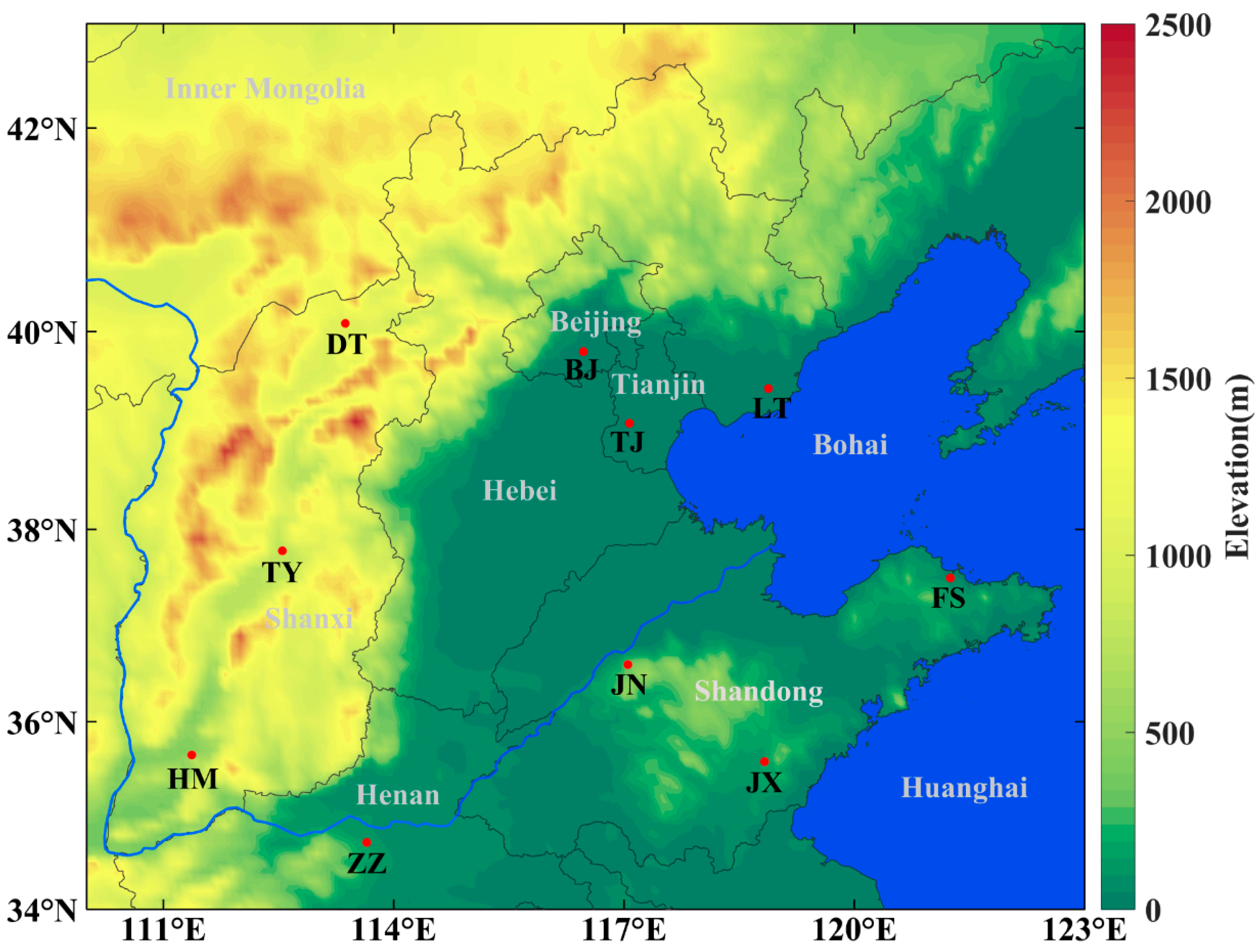
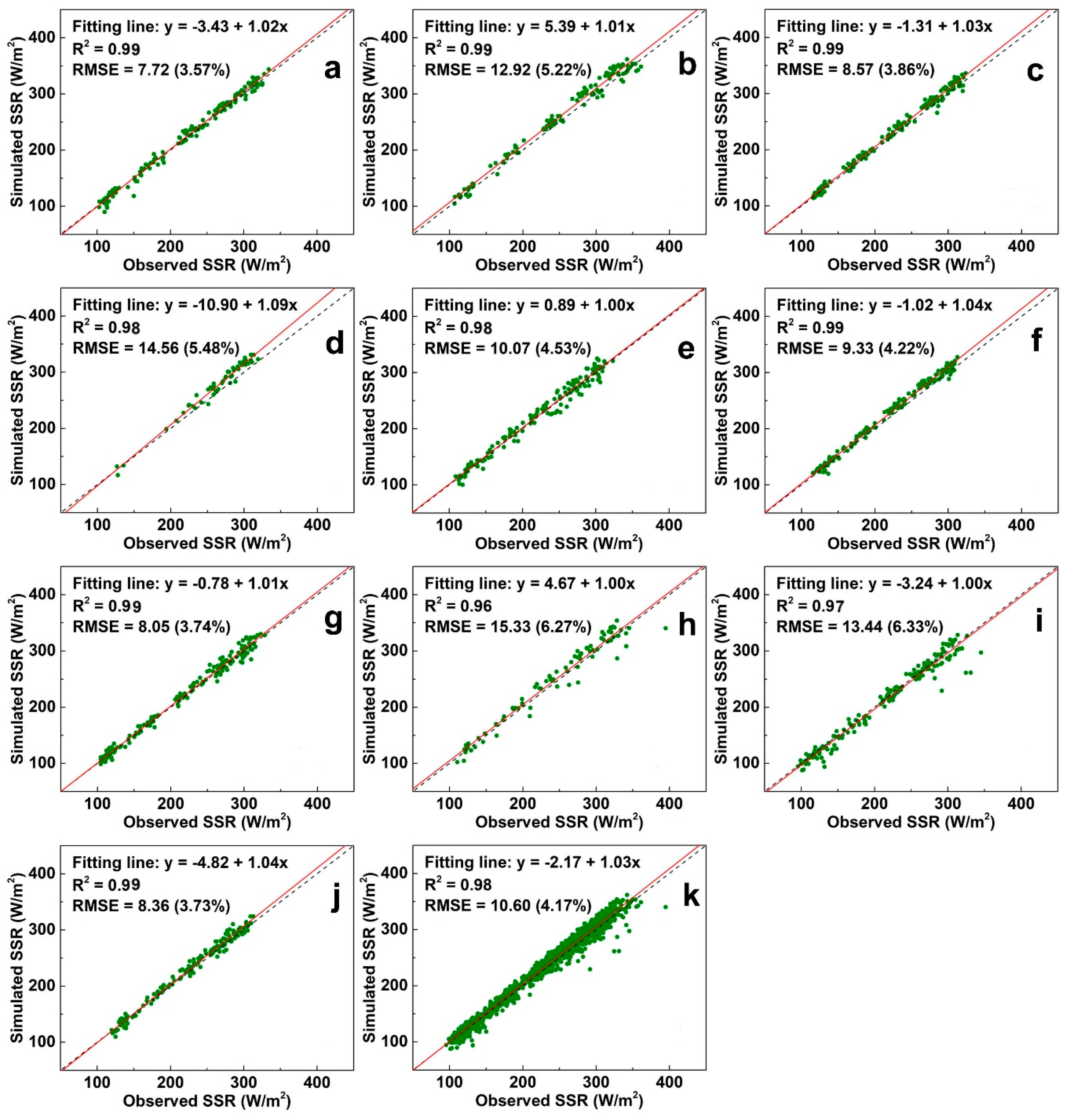
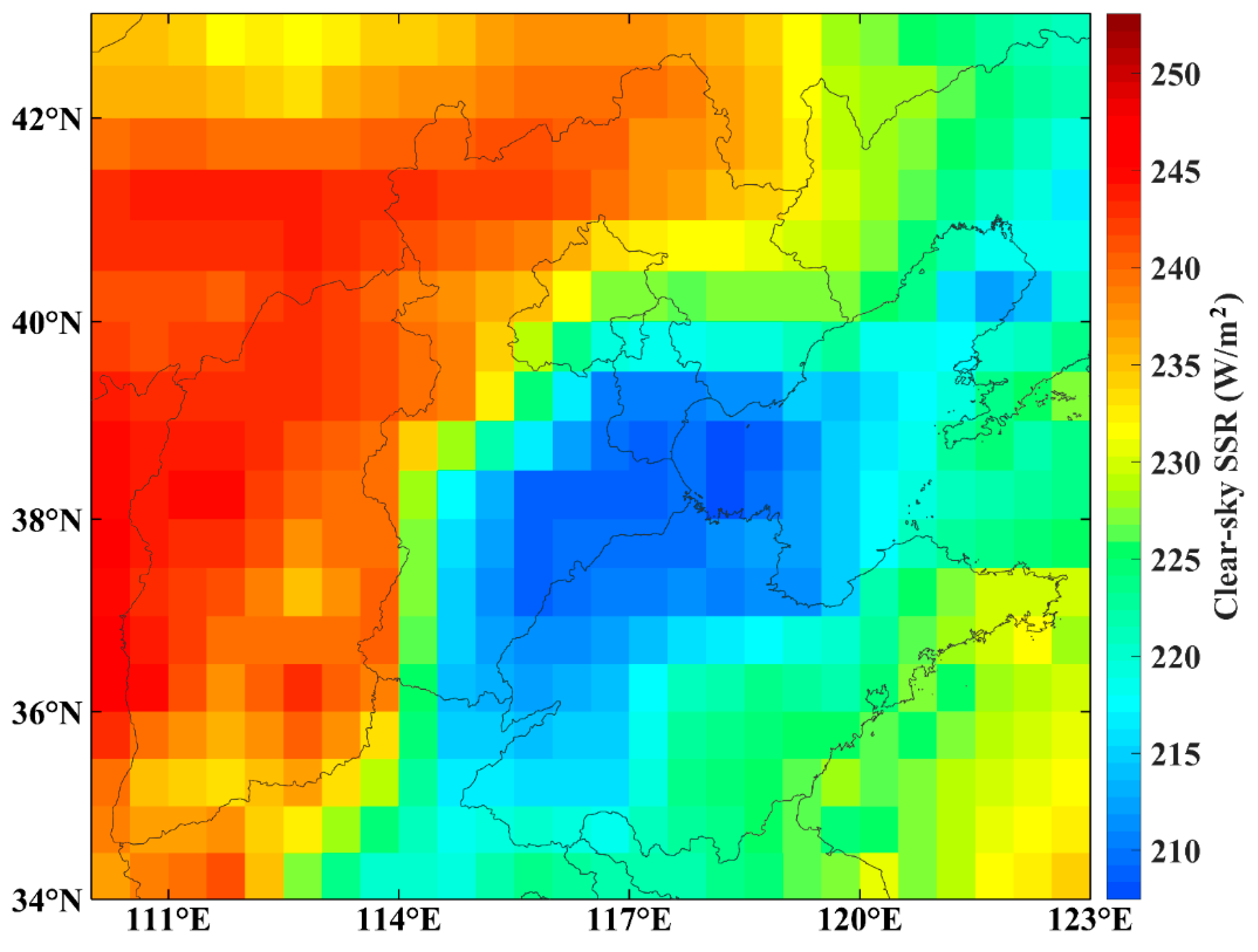
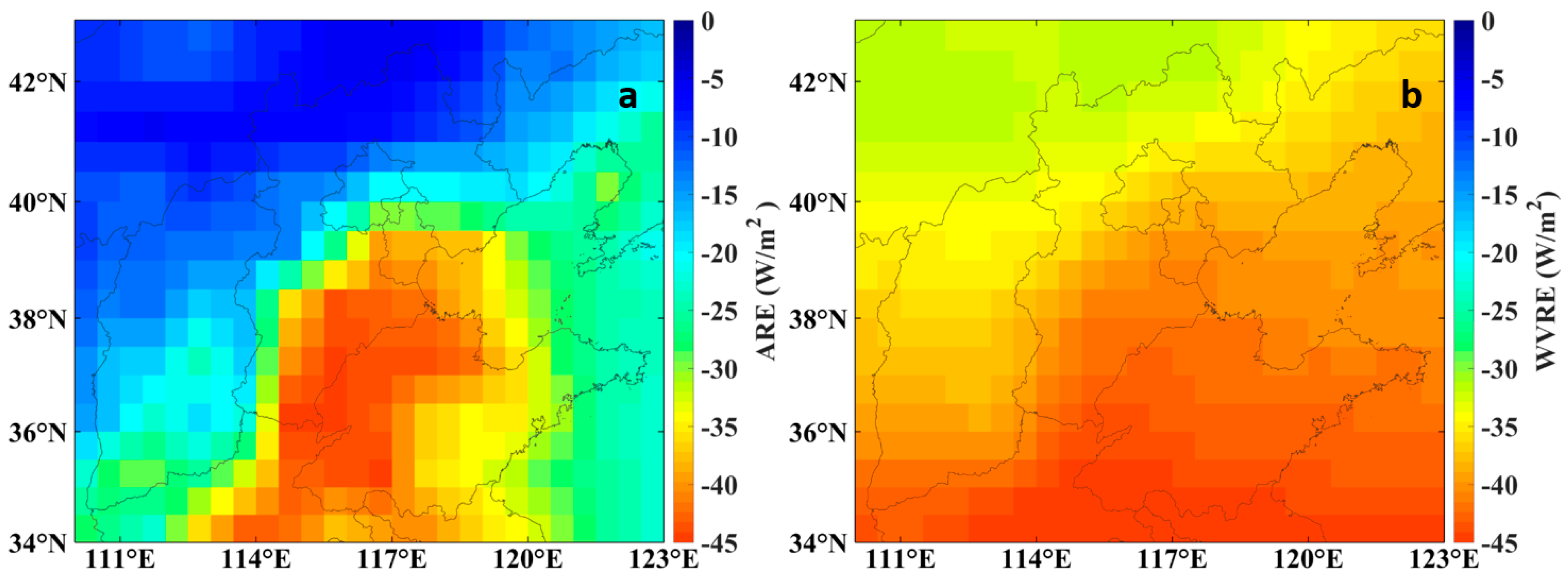
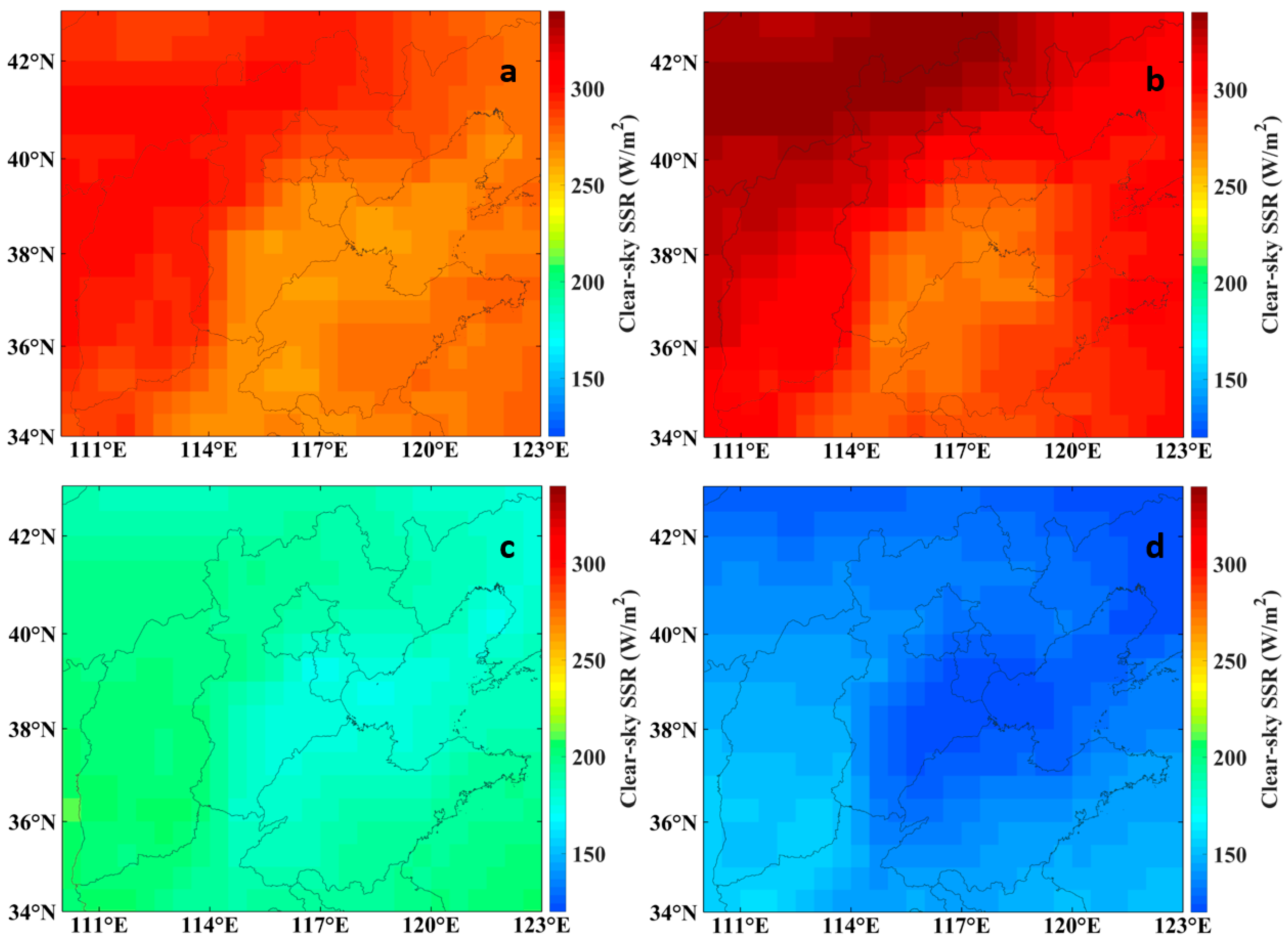
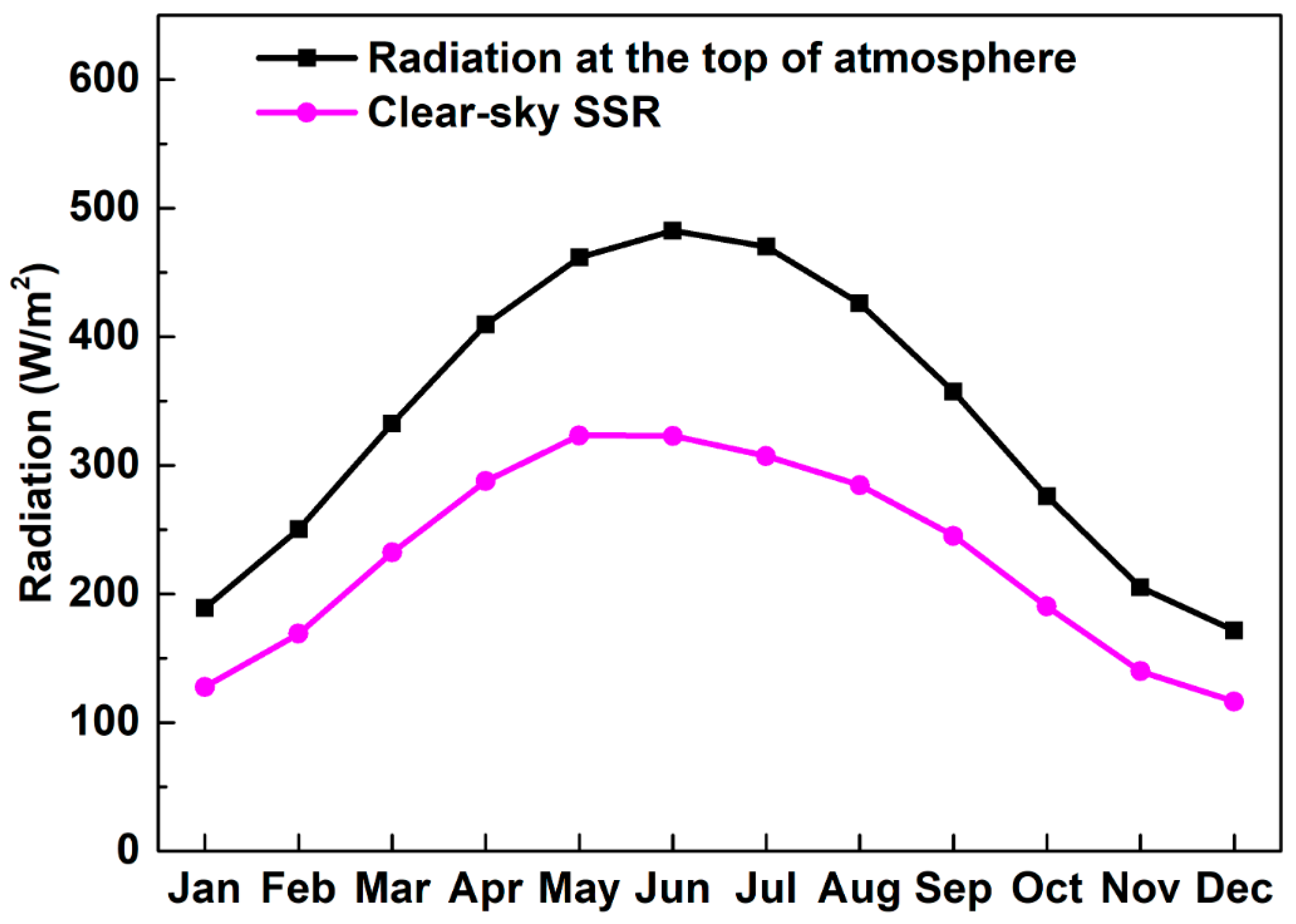
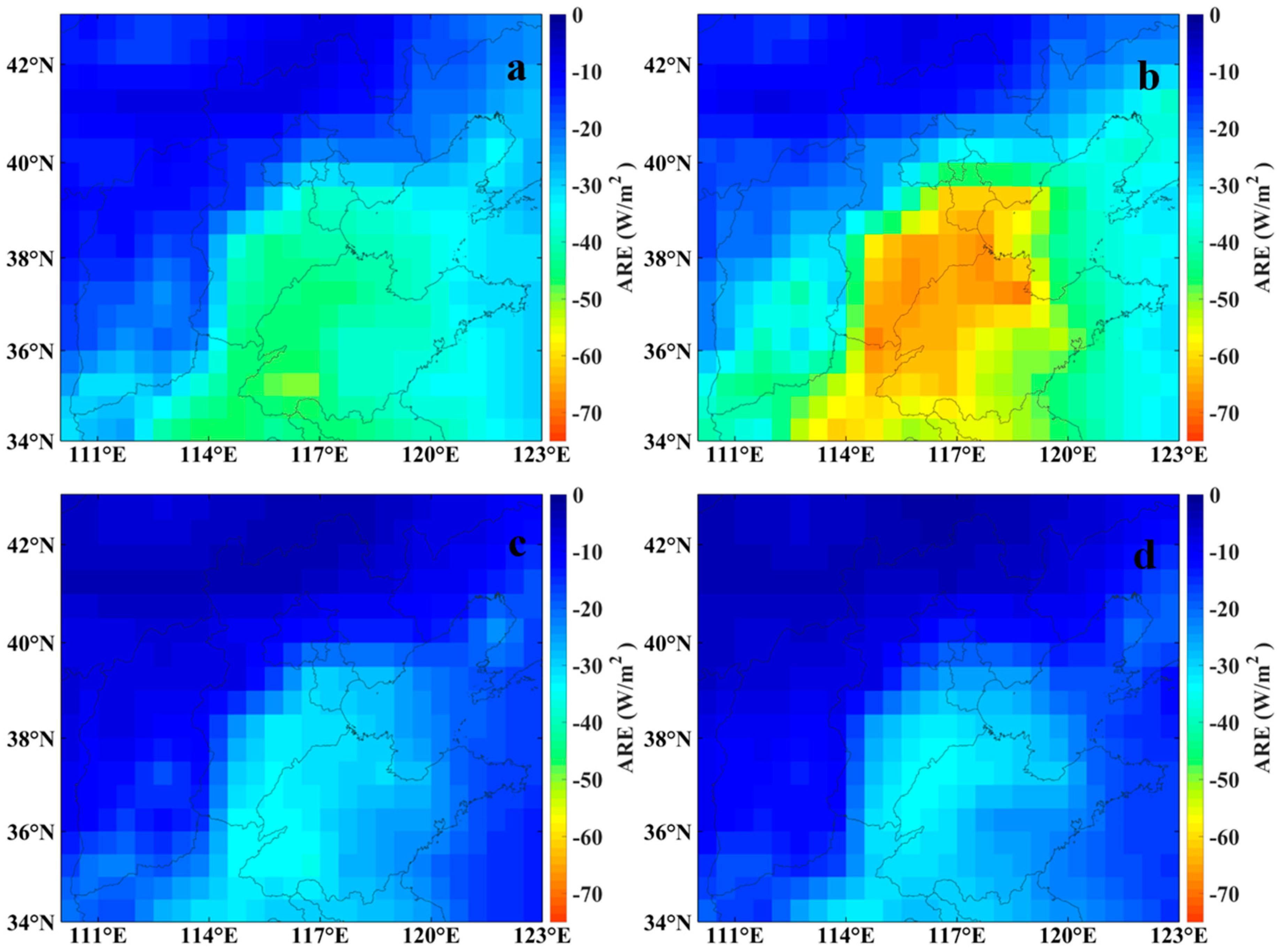
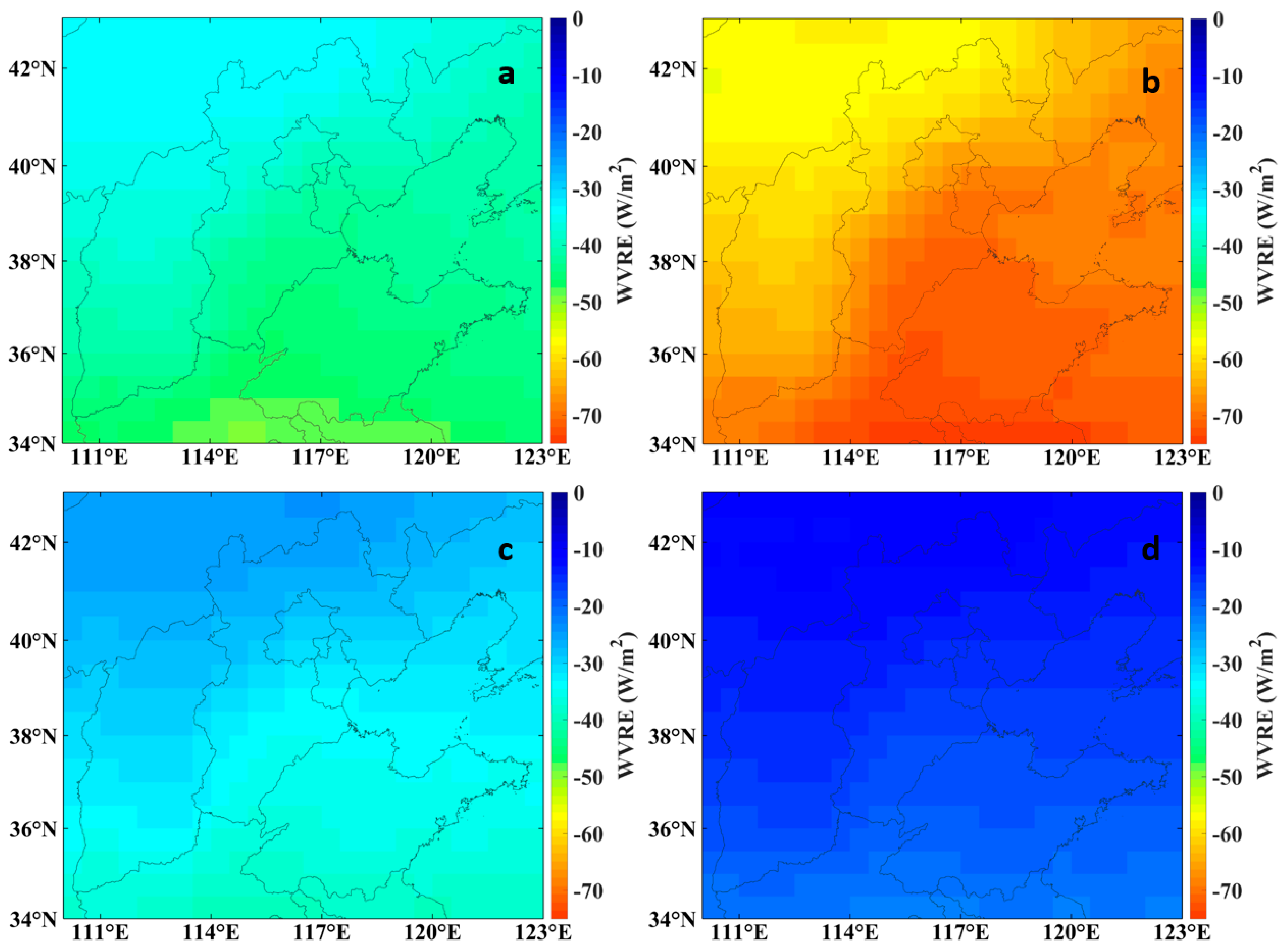


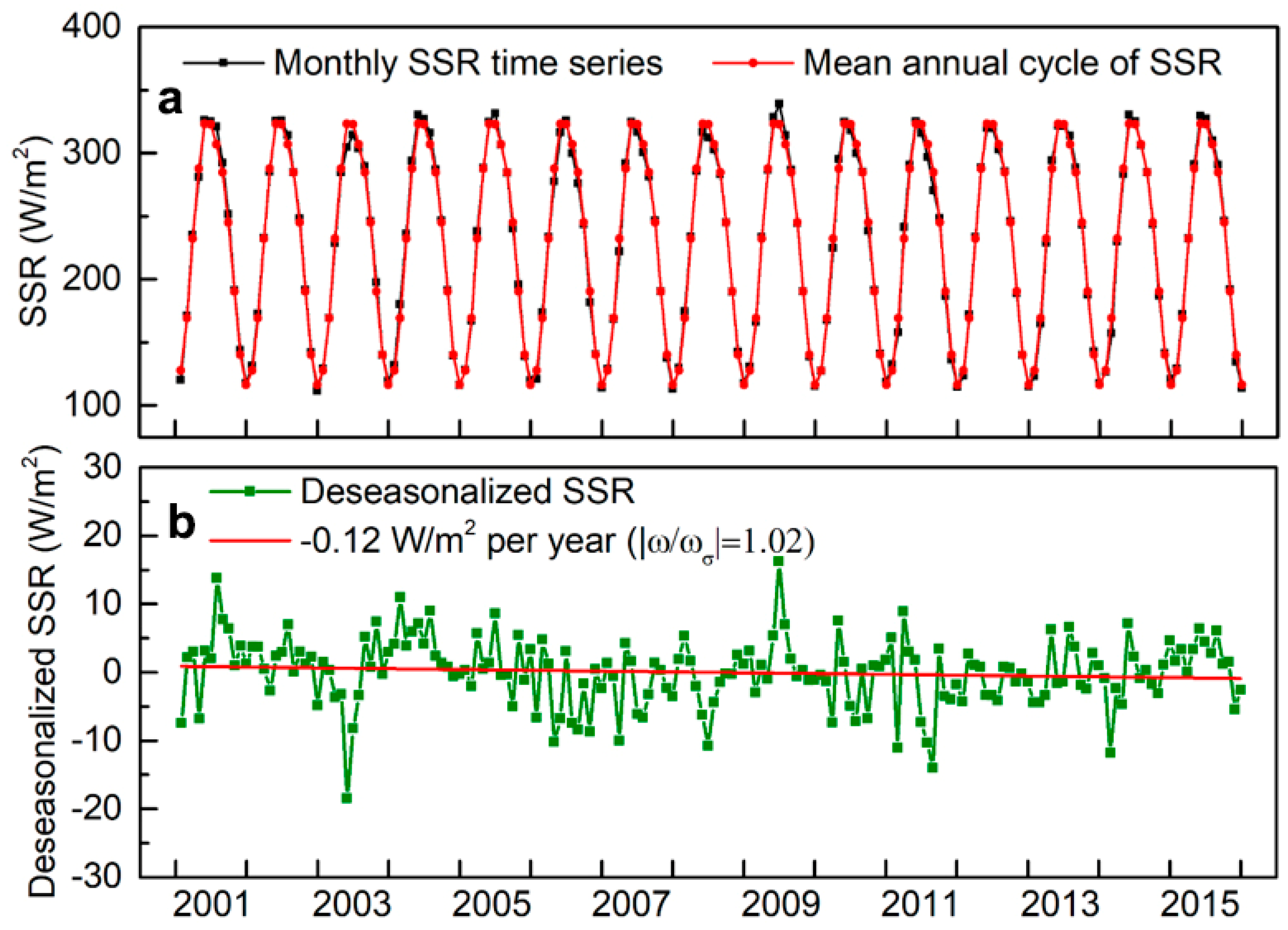
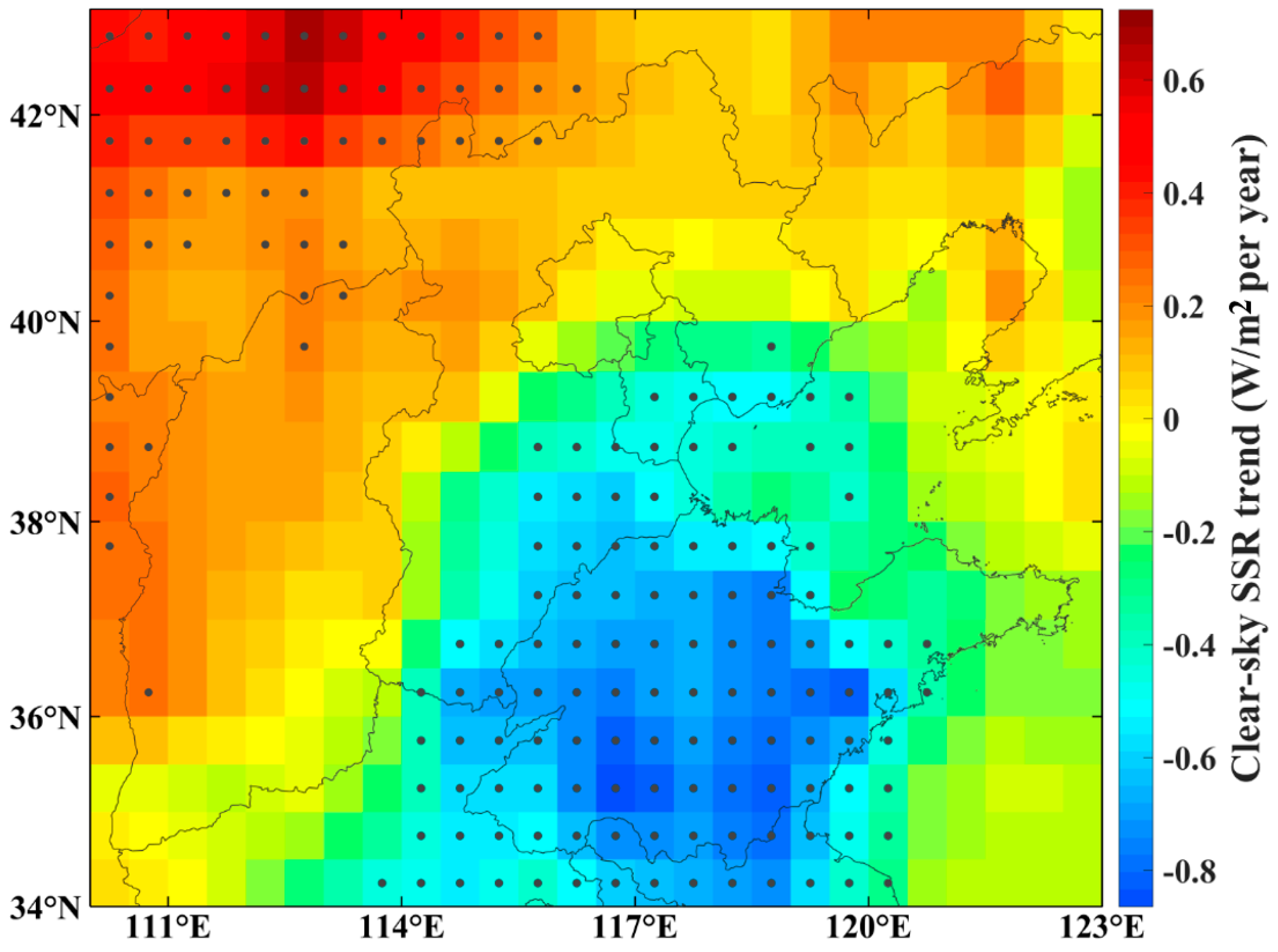
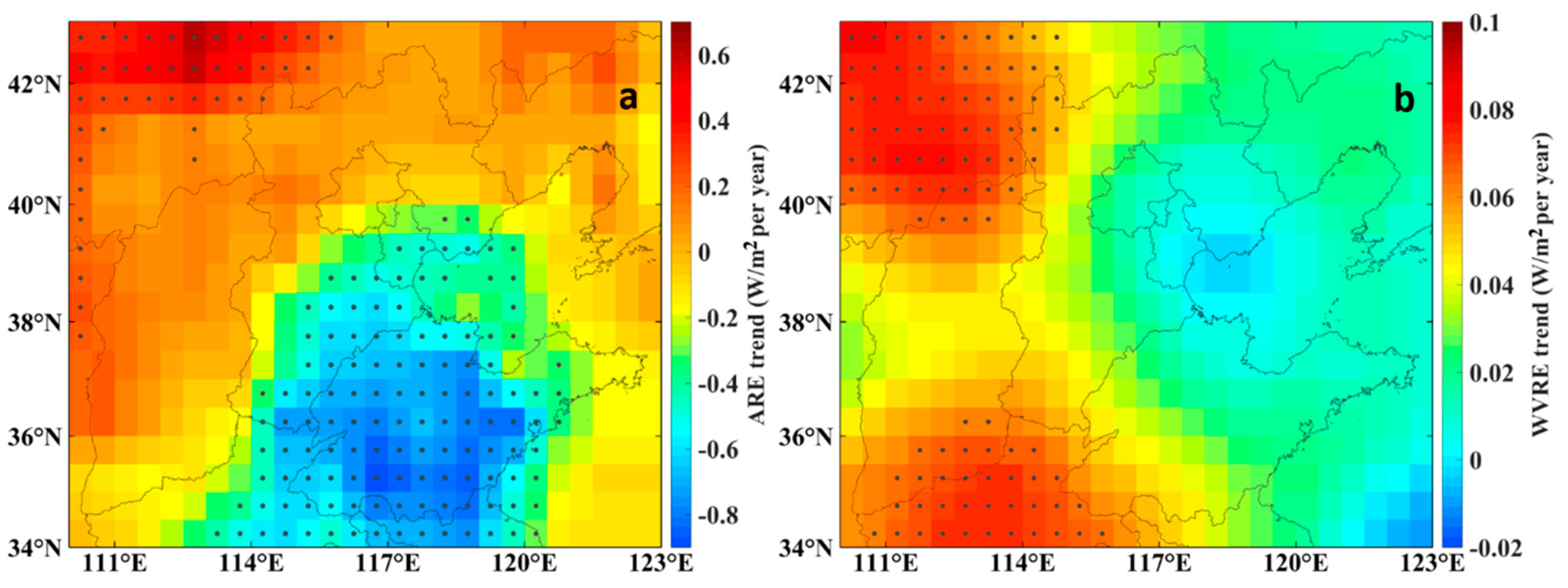
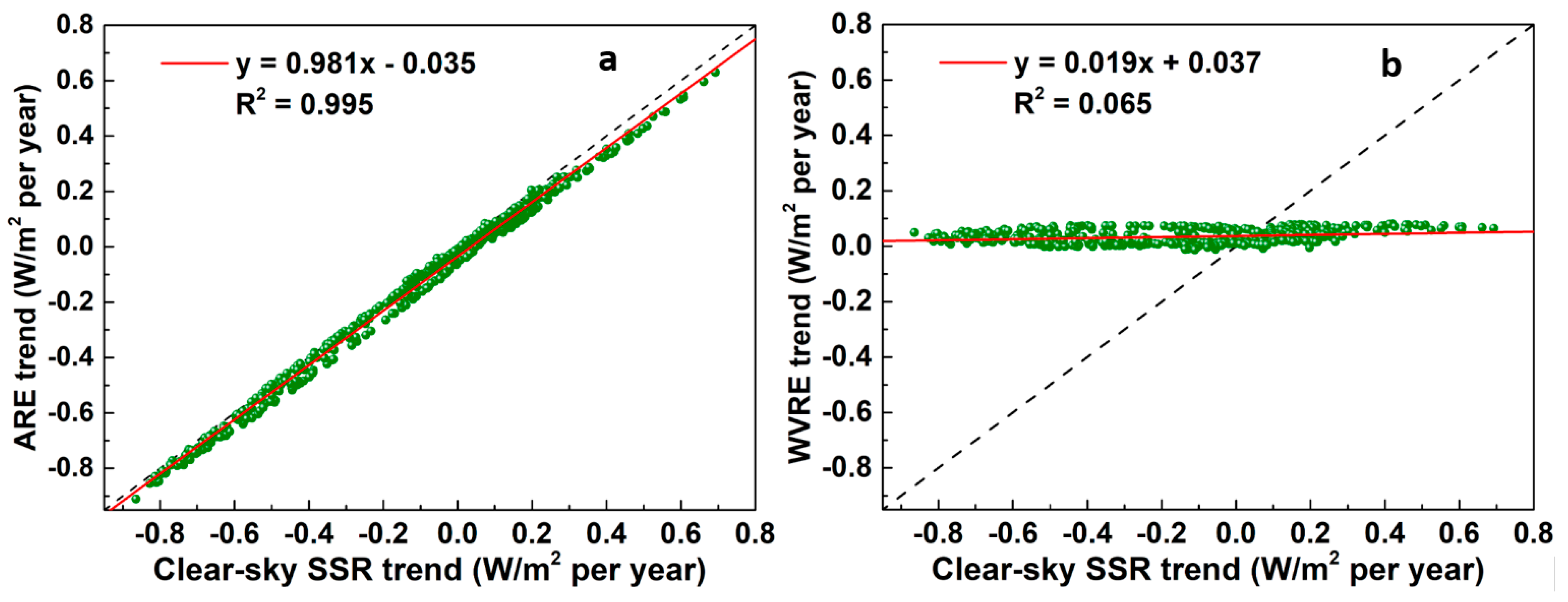
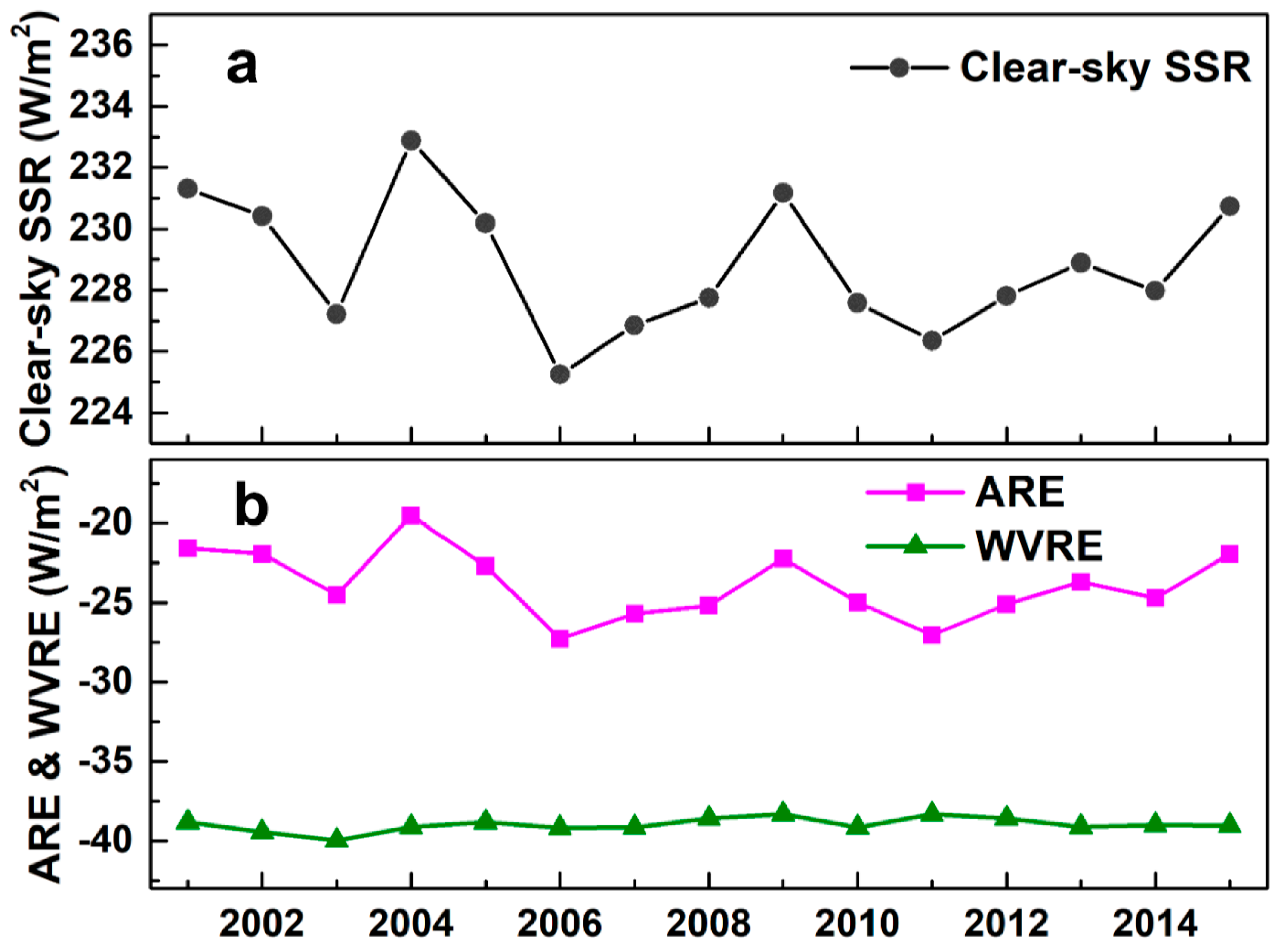

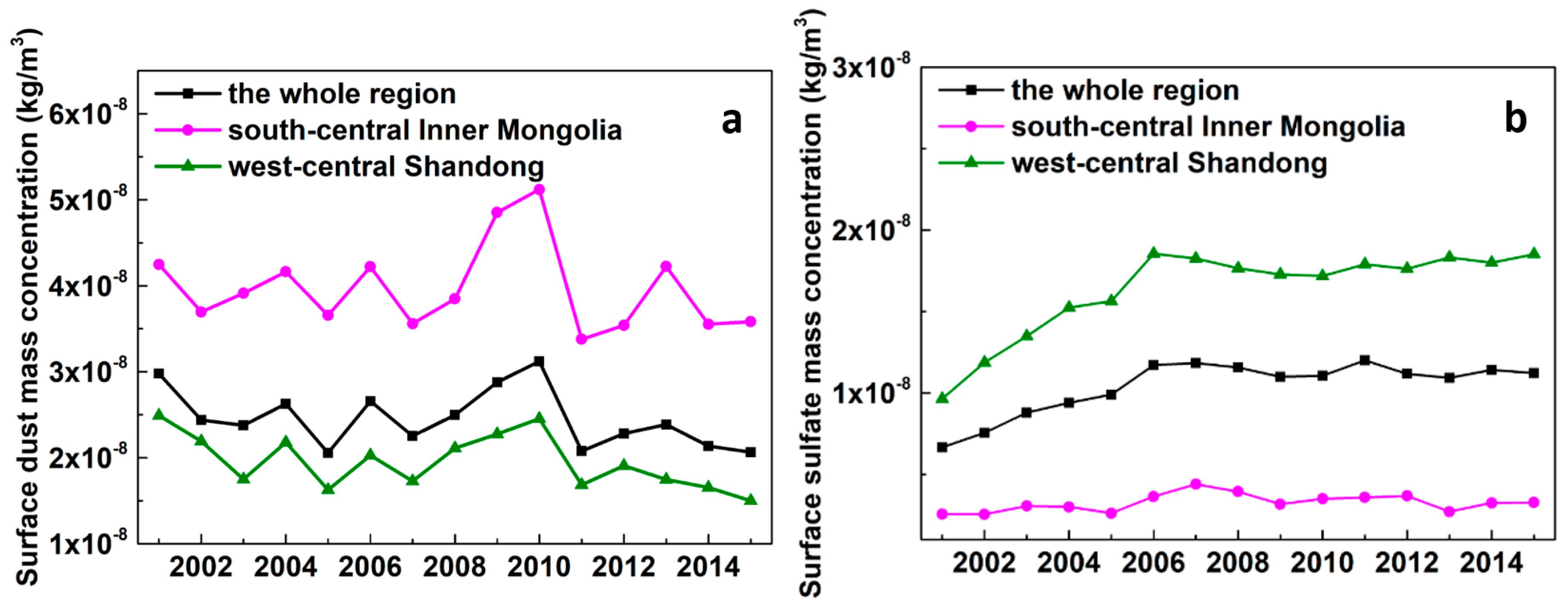
| Stations | Correlation Equation | R2 | MAE (W/m2) | MAE(%) | RMSE (W/m2) | RMSE(%) | Ratio of Clear Sky |
|---|---|---|---|---|---|---|---|
| Datong | y = 1.01x + 5.39 | 0.99 | 10.98 | 4.44% | 12.92 | 5.22% | 25.16% |
| Taiyuan | y = 1.00x + 4.67 | 0.96 | 12.22 | 4.99% | 15.33 | 6.27% | 18.09% |
| Houma | y = 1.09x − 10.90 | 0.98 | 12.98 | 4.87% | 14.56 | 5.48% | 10.88% |
| Beijing | y = 1.02x − 3.43 | 0.99 | 6.25 | 2.89% | 7.72 | 3.57% | 29.12% |
| Tianjin | y = 1.00x − 3.24 | 0.97 | 8.68 | 4.09% | 13.44 | 6.33% | 35.16% |
| Laoting | y = 1.01x − 0.78 | 0.99 | 6.17 | 2.87% | 8.05 | 3.74% | 34.79% |
| Fushan | y = 1.03x − 1.31 | 0.99 | 7.00 | 3.15% | 8.57 | 3.86% | 30.87% |
| Jinan | y = 1.00x + 0.89 | 0.98 | 8.22 | 3.70% | 10.07 | 4.53% | 27.24% |
| JUxian | y = 1.04x − 1.02 | 0.99 | 7.93 | 3.58% | 9.33 | 4.22% | 26.34% |
| Zhengzhou | y = 1.04x − 4.82 | 0.99 | 6.63 | 2.96% | 8.36 | 3.73% | 25.68% |
| all | y = 1.03x − 2.71 | 0.98 | 8.14 | 3.62% | 10.60 | 4.17% | 26.33% |
| Parameter | Perturbation | Change of SSR (W/m2) | Change of SSR (%) |
|---|---|---|---|
| AOD | 0.14|−0.14 | −9.94|10.37 | −3.71|3.87 |
| SSA | 0.06|−0.06 | 12.18|−11.28 | 4.54|−4.21 |
| Water Vapor (kg/m2) | 2.80|−2.80 | −1.72|1.995 | −0.64|0.74 |
© 2020 by the authors. Licensee MDPI, Basel, Switzerland. This article is an open access article distributed under the terms and conditions of the Creative Commons Attribution (CC BY) license (http://creativecommons.org/licenses/by/4.0/).
Share and Cite
Zhang, G.; Ma, Y. Clear-Sky Surface Solar Radiation and the Radiative Effect of Aerosol and Water Vapor Based on Simulations and Satellite Observations over Northern China. Remote Sens. 2020, 12, 1931. https://doi.org/10.3390/rs12121931
Zhang G, Ma Y. Clear-Sky Surface Solar Radiation and the Radiative Effect of Aerosol and Water Vapor Based on Simulations and Satellite Observations over Northern China. Remote Sensing. 2020; 12(12):1931. https://doi.org/10.3390/rs12121931
Chicago/Turabian StyleZhang, Guang, and Yingying Ma. 2020. "Clear-Sky Surface Solar Radiation and the Radiative Effect of Aerosol and Water Vapor Based on Simulations and Satellite Observations over Northern China" Remote Sensing 12, no. 12: 1931. https://doi.org/10.3390/rs12121931
APA StyleZhang, G., & Ma, Y. (2020). Clear-Sky Surface Solar Radiation and the Radiative Effect of Aerosol and Water Vapor Based on Simulations and Satellite Observations over Northern China. Remote Sensing, 12(12), 1931. https://doi.org/10.3390/rs12121931




